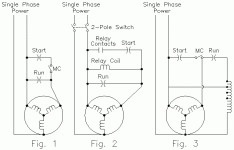Eric Nelson
Lifetime Supporting Member + Moderator
Wait, I found more...
If the motor is small enough, I think Vetteboy's suggestion of a VFD is the best way to go. In any case, I found yet another method in the same book. This sounds like it would take up less room. Again, from "The Electrician's Book of Trade Secrets" (which I guess aren't so 'secret' anymore!)...
Pardon the crappy drawings, I was just trying to duplicate the original author's hand-drawn diagrams as closely as possible...
beerchug
-Eric
P.S. Vetteboy, I agree with you about the '2 phase' jibberish, but I have seen (with my own eyes) motors labeled "TWO PHASE". Go figure!...

If the motor is small enough, I think Vetteboy's suggestion of a VFD is the best way to go. In any case, I found yet another method in the same book. This sounds like it would take up less room. Again, from "The Electrician's Book of Trade Secrets" (which I guess aren't so 'secret' anymore!)...
- RUNNING A THREE PHASE MOTOR WITH SINGLE PHASE POWER
A three phase motor can be run on single phase power by the use of capacitors to create a type of rotating magnetic field in all three windings of the motor.
If you refer to Fig. 1, you will see that one leg of the single phase power is connected to one motor lead, and the other single phase leg is connected to another of the three phase motor's leads. The third motor lead is run first to a capacitor, and then back to one of the single phase leads.
As you notice, there are two capacitors shown in the drawing; one is a "run" capacitor, meaning that it is in the circuit at all times. The other is a "start" capacitor, which is used only for a few seconds at start-up; this is necessary to provide the extra torque that is needed to start the motor. The run capacitor should be an oil type capacitor, as it will be carrying a significant amount of current, and needs to be hefty enough to take a fair amount of heat. This run capacitor should be sized at 25 to 30 mfd per horsepower. The starting capacitor can be of the electrolytic type (which is cheaper), as it will only be in the circuit for a few seconds. This start capacitor should be sized at about 60 mfd per horsepower.
If you have any trouble finding capacitors of the right size, remember that you can "stack" your capacitors; that is, you can hook them up in parallel. Capacitors connected in parallel are additive (a 30 mfd capacitor and a 40 mfd capacitor hooked up in parallel equal 70 mfd); so this should eliminate any such problems.
To operate your motor manually, you will need a regular start switch (single pole, normally open, momentary contact), and wire it as shown in Fig. 1. You must push your start switch, then turn on your single phase power, and then let off of your start switch after the motor is up to speed. In Fig. 2 we are showing a three phase motor being run on single phase power in this same way, but with an automatic (Magnetic) starter.
Because one leg of this three phase power is being made by the use of capacitors, you can get some very unbalanced currents. Because of this, a motor run on this set-up should not be run at more than 75% of its full load for an extended period of time.
In Fig. 3 we are showing a variation of this method which also incorporates an autotransformer to balance the currents better.
You will need to experiment with the autotransformer to find out which of its taps would be the best to use, but using the autotransformer will give you a much more efficient operation. Using this set-up you can run motors up to 100 horsepower or more if necessary.
If properly adjusted, this set-up will operate extremely well at full load, with current in all three legs balanced. At no load however, its operation is not too good.
One note about autotransformers; Autotransformers can be kind of tricky, so handle them with care. Make sure that the autotransformer that you use is rated for the amounts of current and voltage that it will be required to carry.
Also remember that the voltage rating of your three phase motor must match the voltage of your single phase supply."
Pardon the crappy drawings, I was just trying to duplicate the original author's hand-drawn diagrams as closely as possible...
beerchug
-Eric
P.S. Vetteboy, I agree with you about the '2 phase' jibberish, but I have seen (with my own eyes) motors labeled "TWO PHASE". Go figure!...






